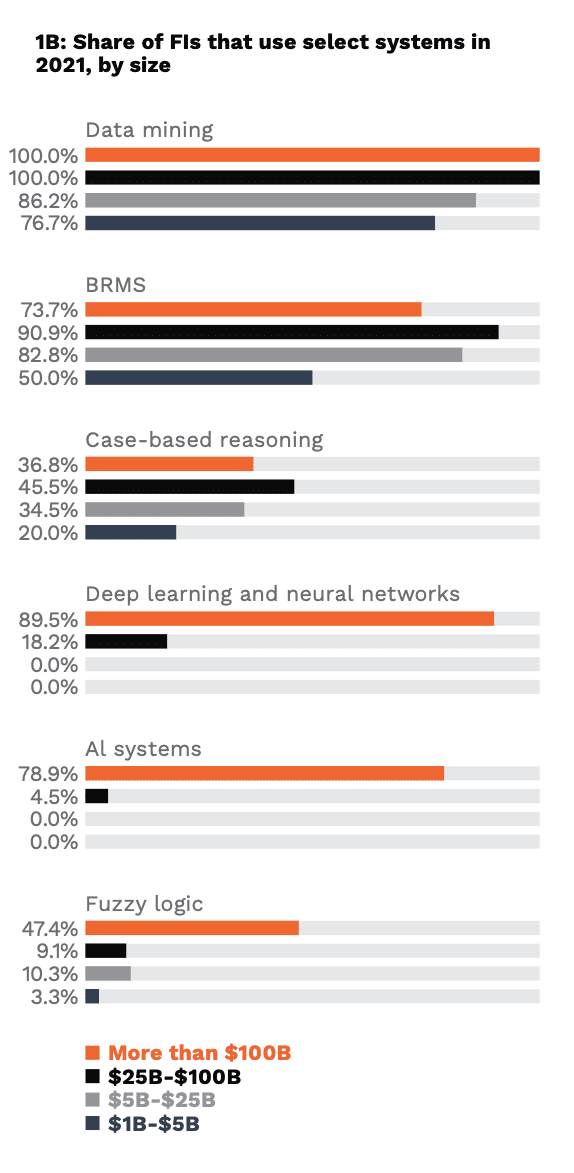New Study: Use Of AI To Lower Risk Has Nearly Tripled Among Financial Institutions

If it seems like companies are slapping artificial intelligence (AI) onto everything in the pandemic era, it’s because so many are. To gauge the focus and direction of rapid developments happening with this powerful technology that “thinks,” PYMNTS proffers the AI In Focus: The Navigating Bank Credit Risk Playbook, done in collaboration with Brighterion.
Based on new survey data from a panel of 100 financial institution (FI) executives and building on work PYMNTS has been doing since 2018, the Playbook notes that “Advances in artificial intelligence (AI) have opened up new paradigms for managing credit risk, allowing banks to leverage real-time data about borrowers and market conditions. These tools effectively act like periscopes, providing 360-degree account-level views and insights — tasks beyond the capability of credit department staffs, however large they might be.”
How well FIs are using AI to manage credit risk, among other operational exigencies, is at the heart of vital findings from this inaugural AI In Focus: Navigating Bank Credit Risk Playbook.

Credit Decisioning Is Getting Smarter
AI has proliferated at a furious pace in just three years, but the technology isn’t cheap. This explains why researchers find it more among much larger financial institutions with deeper pockets.
Per the Playbook, “The share of FIs that use the system has nearly tripled, growing from 5.5 percent in 2018 to 16 percent in 2021. There is a considerable size divide when it comes to adoption, however: 79 percent of banks with more than $100 billion in assets use AI, but only a fraction of smaller banks do. AI has become nearly as prevalent among large banks as more established systems such as data mining and business rules management systems (BRMS), which are used by 100 percent and 74 percent of large FIs, respectively.”
As to where financial institutions are applying AI tools, consumers’ needs are deciding that for them.
“More than a third — 34 percent — of banks consider the economic factors impacting lending and credit to be their greatest challenge over the past year, making it the most frequently cited issue by a considerable margin. Other major concerns include data security, which 26 percent of FIs consider their most important challenge, regulatory compliance (13 percent) and increased competition from FinTechs (13 percent),” the Playbook states.

Goodbye Static Rules, Hello Actionable Insights
As the new Playbook puts it, “Recognizing the necessity of real-time functionality and automation is one thing but, being able to leverage the large volumes of data that go along with these processes is another. This is one reason why AI has become a nexus point for real-time functionality and automation: It can transform large streams of data into actionable insights.”
Those actionable insights extend to mitigating credit risk, as would be expected.
For example, “Identifying potentially delinquent accounts has emerged as one of the main ways FIs are putting AI to use in credit management, with 75 percent of institutions employing AI for this purpose.” Aiding in credit decisions (63 percent), credit/risk underwriting (56 percent) and identifying solutions to potential credit problems (56 percent) are other major uses.
While the new AI In Focus Playbook data is too exhaustive to summarize here, the research “suggests that banks may not fully appreciate AI’s potential to improve credit management operations … and that they may be misapplying more-limited legacy systems. BRMS users are 1.4 times more likely to use the system for credit decisioning than AI users, for example: 90 percent of banks that employ BRMS use it for this purpose, compared to only 63 percent of AI users.”
But the days of static, rules-based systems undergirding credit management are coming to a slow but certain end at the hands of financial AI systems that are getting smarter all the time.

